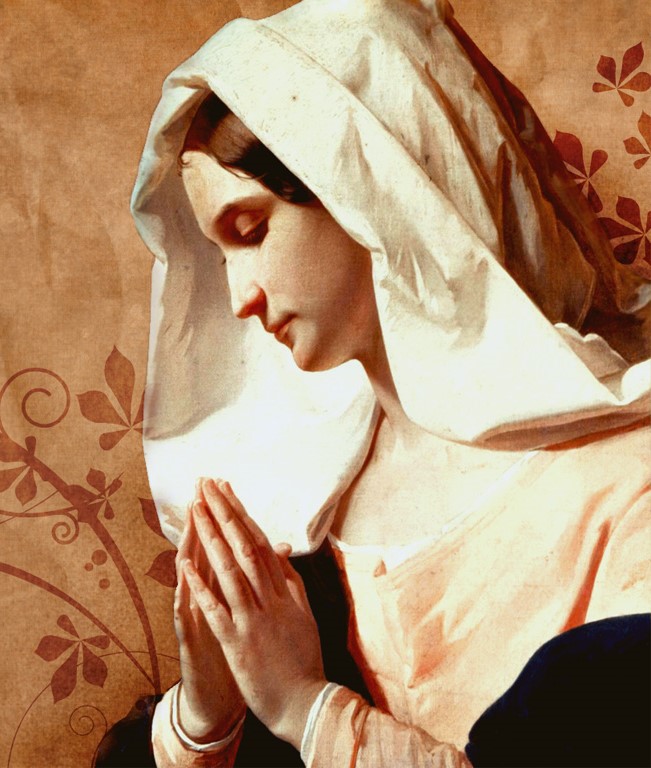Motherlove
Beauséant and Buckler—1 March AD 2023
Scripture Passage: “In the sixth month the angel Gabriel was sent from God to a city of Galilee named Nazareth, to a virgin betrothed to a man whose name was Joseph, of the house of David; and the virgin’s name was Mary. And he came to her and said, ‘Hail, O favored one, the Lord is with you … Do not be afraid, Mary, for you have found favor with God. And behold, you will conceive in your womb and bear a son, and you shall call his name Jesus.’” —Luke 1:26-31
Challenge Message: “Following her example of obedience to God, we can learn to serve delicately without being slavish. In Mary we don’t find the slightest trace of the attitude of [those] who obey, but thoughtlessly. Our Lady listens attentively to what God wants, ponders what she doesn’t fully understand and asks about what she doesn’t know. Then she gives herself completely to doing God’s will: Behold the handmaid of the Lord, be it done unto me according to your word.” —St Josemaria Escriva
The Annunciation
March 25 passes largely unobserved in much, if not most, of the modern Western Church. Yet for the majority of Christian history this has proved an auspicious date indeed. March 25, precisely nine months before Christmas, commemorates the Annunciation—sometimes known in English circles as Lady Day—when the angel Gabriel announced to the Blessed Virgin Mary that she would bear the Son of God.
This event marks the beginning of the Incarnation; that is, of the Creator becoming one with Creation by taking on human flesh. Regardless of our stances on when human life begins, we cannot deny that each of us begins within the womb. And so Mary becomes what Martin Luther called finitum capax infiniti: the finite containing the Infinite. She is the New Ark bearing forth the New Creation. She is, in short, the Theotokos, the Holy Mother of God. To deny her this title would be to deny the divinity of her Son.
Medieval tradition understood that March 25 marked not only the date of Jesus’ death on that first Good Friday, but also the date of His conception. Regardless of its historical accuracy, the symbolic power of this date proved too good to pass up. Corresponding roughly with the spring equinox, March 25 marked for many the start of the New Year—as it would in the British Empire and American Colonies until our adoption of the Gregorian calendar in the mid-eighteenth century. Those country folk who kept the old New Year’s celebration in spring were later lambasted as “April Fools.”
Certain schools of Judaism held March 25 to have been the first day of Creation, as well as the date of Abraham’s “unsacrifice” of Isaac. Christians enthusiastically adopted it as the first day of the New Creation in Jesus Christ as well, the day of Mary’s “Let it be” corresponding to the day of God’s “Let there be light.” Even the fall of Lucifer and the parting of the Red Sea where later said to have occurred on March 25. In short, it was a date of endings and new beginnings, of fallings and of risings.
It’s no coincidence, then, that J.R.R. Tolkien, as a devout Roman Catholic, chose this specific date for the destruction of the One Ring in the fires of Mount Doom. The ancient stories stay with us still, though they sometimes come to us in different form.
It’s true that Christian denominations differ greatly regarding the emphasis put upon Jesus’ Mother Mary. For some she proves little more than an afterthought, remembered only sentimentally at Christmas; while for others she often appears so reverenced as to be nearly equated with her divine Son. What cannot be denied is that devotion to the Virgin Mary, as an extension of devotion to Jesus Christ, dates back to the earliest centuries of our faith. The oldest extant hymn to Mary easily predates the Nicene Creed.
For those to whom this all seems odd, those who come from a tradition in which Mary plays a lesser role in Christian devotion, what are we to make of this? Why this seeming obsession with the mother of Jesus Christ? Poor Joseph gets not half so much attention. We might be surprised to learn that even Protestant Reformers such as Luther and Calvin held deeply personal Marian devotions.
Mary the Mother of God mystically represents humanity as a whole. Time and again the Church Fathers stress that we are to take her as our model, incubating Christ within us, that He may be born through us again into our own generation and culture. The promises given to Mary—sinlessness, union with Christ, assumption into Heaven, coronation above all angels—are given to all of the faithful, and to all of Creation in the age to come. She is a microcosm for the work which God seeks to complete within us all: salvation, resurrection, and eternal exaltation.
Indeed, throughout the history of the Church, Christians are likened to three women: Maria, Ecclesia, and Sophia. That is, the Virgin Mary, the Church as the Bride of Christ, and Holy Wisdom as the personification of all of Creation redeemed. Mary as an individual, the Church as a community, and Sophia as the whole of the cosmos perfected, each embody the love between God and Creation, between Christ and His Holy Bride.
Perhaps some of us go too far in our devotion to the Virgin Mary. Perhaps some of us do not go far enough. I’m inclined to lean toward the opinion of Maximilian Kolbe, who wrote: “Never be afraid of loving the Blessed Virgin too much. You can never love her more than Jesus did.” Either way, the Church honors Mary not apart from Jesus Christ but precisely because He comes to us through her—and would come now to others through us.
In Jesus. Amen.

Comments
Post a Comment